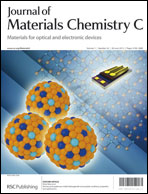Photophysical properties of [Ir(tpy)2]3+-doped silica nanoparticles and synthesis of a colour-tunable material based on an Ir(core)–Eu(shell) derivative†‡
Abstract
In this study, we report the synthesis and characterization of phosphorescent silica nanoparticles doped with the blue-greenish emitting Ir-tpy complex [Ir(tpy)2]X3 (tpy = 2,2′:6′,2′′-terpyridine; X = PF6− or NO3−). Depending on the type of counterion and the solubility of the complex, three different kinds of Ir(tpy)-doped silica nanoparticles were prepared by the Stöber, water-in-oil and direct micelle synthetic approaches. The materials prepared through the Stöber and the water-in-oil approaches showed enhanced photochemical stability and higher luminescence efficiency compared to the free Ir-tpy complex. In these cases, the silica matrix hampers the diffusion of O2 and restrains the mobility of the complexes resulting in a decrease of the vibration relaxation and restraining the nonradiative decay. Conversely, for the material prepared by the direct micelle method, in which the structure of silica shows some degree of mesoporosity, the luminescence properties of the Ir-tpy complex remained almost unchanged after silica encapsulation. Additionally, the nanoparticles prepared by the Stöber method were chosen to functionalize their surface with a red-emitting Eu(hfac)3-alkoxysilane derivative leading to multicoloured luminescent silica nanoparticles in which the colour of the emission could be tuned by changing the excitation wavelength and where an Ir → Eu energy transfer was evidenced.
![Graphical abstract: Photophysical properties of [Ir(tpy)2]3+-doped silica nanoparticles and synthesis of a colour-tunable material based on an Ir(core)–Eu(shell) derivative](/en/Image/Get?imageInfo.ImageType=GA&imageInfo.ImageIdentifier.ManuscriptID=C3TC30466C&imageInfo.ImageIdentifier.Year=2013)

 Please wait while we load your content...
Please wait while we load your content...